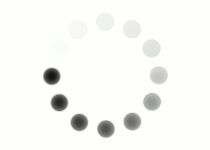So far, you've learned how to measure angles with a protractor. You can also use a protractor to draw angles--a necessary step for figuring out if your screen-viewing habits are healthy. Let's look back at this student's approach to viewing a computer screen. How would being able to draw an angle help you determine if her viewing position is as it should be?

OSHA research indicates that the safe angle of computer viewing is 15 to 20°. Since angles don't just appear in the air in front of computer users, you would need to draw the angle before you could use a protractor to measure it accurately. Another approach would be to draw a 20° angle on a thin piece of paper and then hold it up to the screen to compare. Either way, you need to know how to draw an angle, given a certain number of degrees.
Use these slides to learn how to draw angles with a protractor. Follow along with your own protractor and a piece of paper, creating your own 20° angle as your click through the steps.
|
First, draw and label a line segment. (It helps to label points from the beginning so you can easily identify them or talk about them.) In our sample, we are using ¯AB. 
Align the center of the straight side of your protractor above a segment endpoint. Either endpoint could be used, but in this drawing, we are using point A, so A will be the vertex of the angle. 
On the curved part of the protractor, identify the degrees for the angle you wish to draw--in this case, the number 20. Use the inner row of measurements since the base crosses 0° of the inner row. 
Using your pencil, make a mark on your paper next to the correct degree mark on the protractor, as shown in the image below. 
Then, remove the protractor and label the mark. You can choose any letter that is not already part of your original segment. In this example, we are using C. 
Finally, use your straightedge to connect the mark at point C to point A. This gives you ray →AC. 
|
Now try drawing a 30° angle using point B as the vertex. When you have finished drawing your angle, click the button below to check your work.

